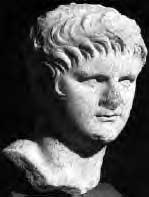|
Argentorate under Neron time

Under Néron a new
enclosure was built, bringing Strasbourg-Argentorate to its final size, in
preparation for what was going to be this city : the key of a Rhenish passage,
exposed to the invasions but also the noud of the exchanges between Gaulle and
the conquered part of Germanie
The Legion
In 47 after J.C. a detachment of XXIe legion is
in station (it is it which builds this new enclosure according to a
town-planning leading to a structured roadway system). Before 70
it is a detachment of XIVe Gemina which is set up.
The military risings caused by the death of
Néron had as a consequence the destruction by the fire of the military camps of
the valley of the Rhine.
Population
Little before this time the arrival IIème legion undoubtedly has
triplet the population to go up to 18 000 inhabitants. The density of the
ceramic marks stronger and the transfer of the cemetery towards the west to
Koenigshoffen are there to prove it. The floods of 50/60 and sets fire to it of
70 brought back the city to the surrounding of 16 000 hearts.
The purpose of
work of enlarging of Argentorate by the 21st legion also was to support, with
the accesses of the city, the concentration in the new civil districts of a
heterogeneous population and multiraciale.
Wine and life
The
wine amphoras coming from Italy and of Gaulle Southerner are very numerous at
the time of Claude and Néron : the use of the wine is with its apogee. Dumoins
that coming from Campanie and other traditional producing areas, since it is
thought that after 70 the drunk wine with Argentorate came from Gaulle and was
transported out of barrels.
Remainders of large shells of
oyster the same period let imagine the dinners which the officers in the
restaurants found under the Kléber place or in their mess could offer (localised
of with dimensions of the burned street) !
The "foie gras" of goose
Since old times, the Greeks and the Romans used
the goose livers to make dishes. In year 52 before our era, the consul Metellus
Pius Scipio, brother-in-law of Pumped, made to gaver geese in the darkness with
figs in order to obtain foie gras. Under Néron times, the foie gras was
also in honor on the tables. Art
There remains to us this
time a bust applies of Dyonisos. Of narbonnaise influence it is carried out in a
style baroque : the exuberant and complicated hairstyle is opposed to a
realistic and simple figure and one draped dry.
Excavations
- Lane Medard Saint : the floods, caused by the
significant ones believed of the Rhine of the time (60 after JC), filled the ditch of the camp
which was then embanked to build quarters out of wooden there.
- Place Pierre Saint the Young
person : a district inhabited at the beginning of the 1 er century
is transformed into this period of believed by a marsh.
- Place of the cathedral :
it was found that at that time a monumental input was arranged as well as a
passage towards the Praetorian way. These constructions were to allow the
admission of civil inside the camp.
- Broglie Place of the
excavations carried out in the years 1970 showed that it is at the time of Néron
that XXIe legion carried out the construction of a new enclosure which will be
largest of the Roman time.
These platforms inside the
castrum, out of stones, discovered and described by E.Kern formed part of the defensive
system built at the time néronienne. Ground liftings were between these
platforms.
- Quay Lezay Marnésia : a rampart préflavien is found.
- Place Etienne Saint : is discovered a double interior track with
the camp (via sagularis)
- Kléber Place : after the floods of 50/60
the ground is embanked, of the dwellings are built and the district is organized
in streets under stratigraphic Néron.(niveau of the time made up of gravel and
bois:137,05m with 137,55m according to Cl work's Schaeffer 1920)
- Street of
garlic : discovered of a wearing of river in activity at that time then
embanked and being used as dump with a workshop of potters of VIIIème legion at
the end of Ier century.
The Rhine
It is clear that this large
river with the brutal risings was one of the strategic elements which guided the
establishment of Argentorate but it is proven that commercial and military
navigation was also done on the rivers : Ill, Beetle, channels and arm of this
tangle which were to be the inland waterways.
Moreover during the time
which followed one found a dedication with the Rhine Father and the existence of
a schola of the nautes of the Rhine.
From a geological point of
view it is it should be noted that at that time the ground water was definitely
higher than currently.
Burials
The tombs of the time are
mainly on named the well road of the Romans.
Assessment of Néron with
Argentorate
The final enlarging
of this camp, its integration of the civil populations and the quite Roman
culture which existed there with the daily newspaper are to be put in parallel
with the urbanistic ambitions, the attraction for the people and the way of life
of Néron.

|



